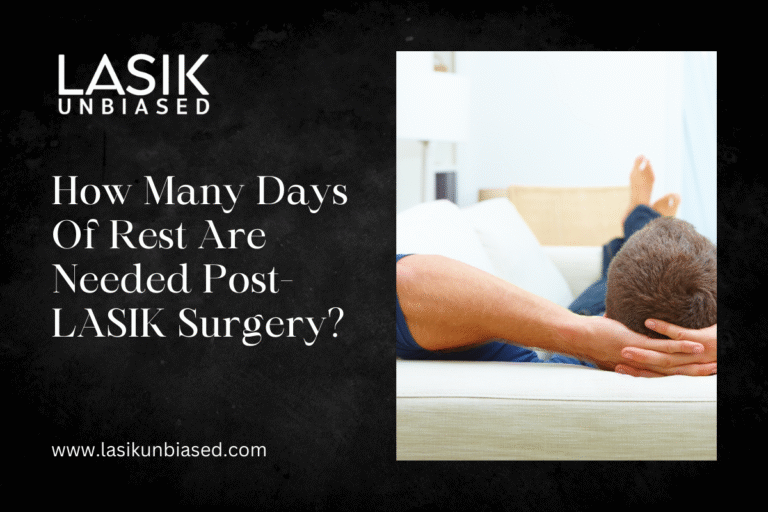You typically need 24 to 48 hours of rest post-LASIK surgery to resume most daily activities, but more demanding tasks or full recovery may require additional time, depending on your individual healing process.
Understanding the recovery timeline ensures your eyes heal properly and you achieve the best vision outcomes.
What Happens Immediately After LASIK Surgery?
The recovery process begins the moment the LASIK procedure ends. Although LASIK is minimally invasive and relatively quick, your corneal flap needs time to heal, which is why rest is critical.
Recovery in the First 24 to 48 Hours
During the first 24 hours, expect your vision to stabilise gradually. Some patients experience blurry vision, mild discomfort, or watery eyes as the corneal flap settles into place. Doctors recommend resting your eyes as much as possible to avoid straining them. Avoid screen time, reading, or exposure to bright light.
Key tips for the first day:
- Keep your protective eye shields on, especially while sleeping.
- Use prescribed eye drops to prevent infection and moisturise the eyes.
- Avoid touching or rubbing your eyes to prevent flap displacement.
When Can You Resume Daily Activities?
Returning to your daily routine can depend on the nature of your activities. Here’s a breakdown to help manage expectations:
Resuming Work
Most patients return to desk jobs within 1-3 days post-surgery, assuming the work does not strain the eyes. For roles requiring extensive screen time, take frequent breaks and follow the 20-20-20 rule (look at an object 20 feet away for 20 seconds every 20 minutes). For outdoor jobs, ensure protective eyewear is used to shield your eyes from dust or UV rays.
Driving
You may be cleared to drive within a day or two after a follow-up eye exam confirming appropriate vision correction. Keep in mind that night driving may be challenging initially due to halos or glare, common early side effects of LASIK.
Physical Activities
- Light Exercise: Gentle activities like walking can resume after 2-3 days. Avoid sweat from entering your eyes.
- Intense Workouts: Allow at least a week before resuming high-intensity activities. However, for contact sports or any activities that pose a risk of eye injury, additional recovery time may be necessary to ensure complete healing and proper protection. Swimming and activities involving water exposure should generally be avoided for two weeks to reduce the risk of infection.
How Long Should You Rest After LASIK for Full Vision Recovery?
While most patients achieve clear vision within a week, complete healing and stabilisation of vision may take up to 3-6 months. During this period, your vision may fluctuate, which is part of the normal healing process.
Long-Term Rest Tips
- Continue using lubricating eye drops as recommended to manage dryness.
- Schedule regular follow-up visits to monitor healing progress and detect potential complications early.
- Protect your eyes from prolonged sun exposure by wearing UV-blocking sunglasses.
What Factors Can Affect Post-LASIK Recovery Time?
Each patient’s recovery timeline is unique, with several factors influencing how much rest is ideal:
Individual Healing Ability
Age, immune response, and overall eye health play a significant role. Younger individuals often recover faster, while older patients might require slightly more time for healing.
Compliance with Aftercare
Strict adherence to post-surgery instructions significantly impacts recovery. Neglecting precautions, such as avoiding rubbing your eyes or missing follow-up appointments, can prolong healing or lead to complications.
Pre-Existing Conditions
Patients with underlying issues like dry eye syndrome or high levels of nearsightedness may experience slower recovery. Make sure your healthcare provider addresses these during pre-surgery consultations.
Common Symptoms During Recovery (And How Much Rest They Need?)
Understanding typical post-operative symptoms can help you plan appropriate rest periods.
Light Sensitivity
Sensitivity to bright light is common in the first few days. Rest in dimly lit rooms and wear sunglasses outdoors to minimise discomfort.
Dry Eyes
Expect temporary dryness, which can last a few weeks to several months in some cases, especially if you have pre-existing dry eye conditions. Use lubricating eye drops frequently to alleviate irritation, especially when working or during prolonged screen exposure.
Halos and Glare
These visual disturbances are usually temporary, subsiding around 7-10 days after surgery. Limiting night-time screen use can help manage these symptoms during recovery.
Why Rest Is Essential for Successful LASIK Recovery?
Resting after LASIK allows your corneal flap to reattach securely and prevents complications such as infections or vision regression. Overexerting your eyes too soon can delay healing and compromise the success of the procedure.
Risks of Skipping Rest
- Extended recovery time
- Increased chance of flap misalignment
- Higher likelihood of complications like dry eye or infection
Prioritising rest sets the foundation for long-term visual improvement and stability.
Tips to Maximise Rest After LASIK Surgery
Taking proactive steps can enhance recovery and ensure your eyes heal optimally:
- Set Up a Restful Environment: Dim lighting, a quiet atmosphere, and minimal screen exposure can help you relax fully.
- Maintain Proper Hydration: Drinking enough water aids overall healing and helps with dry eyes.
- Prepare Meals in Advance: Avoid straining your eyes by preparing meals or organising help with cooking ahead of time.
- Plan Follow-Ups: Stick to the recommended schedule for check-ups with your ophthalmologist.
How Many Rest Days Are Ideal Post-LASIK?
While most patients feel ready to resume their routines within a couple of days, adequate rest is subjective and depends on individual factors such as job demands, lifestyle, and recovery conditions. Aim to give yourself at least two to three days before any rigorous activities and consult with your eye doctor for personalised recommendations.
Key Takeaways for LASIK Recovery
- Rest is crucial during LASIK recovery to ensure proper healing and vision stabilisation.
- Most routines, like work and light exercises, can resume within a few days.
- Recovery timelines vary, but full stabilisation may take several months.
- Follow your doctor’s advice and aftercare instructions meticulously.
Protect your investment in better vision by giving your eyes the care and rest they deserve.


